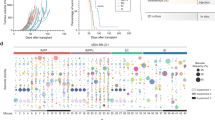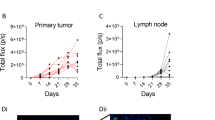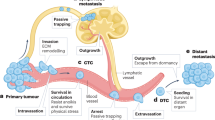Abstract
Establishment of distant metastases by solid tumours requires that some tumour cells separate from the primary growth, infiltrate surrounding normal tissues, invade blood vessels or lymphatic channels, and extravasate into microenvironments favourable for proliferation1. It is probable that only a small subpopulation of tumour cells is endowed with these special attributes2. The biological properties of potentially metastatic tumour cells are being investigated extensively by means of an ‘experimental metastasis’ assay, in which cultured cells are introduced directly into blood vessels and, several weeks later, organs examined for tumour growths1–8. Although this assay allows controlled and quantitative experimentation, the suitability of experimental metastasis (colonization) as a valid representation of true metastasis is uncertain. I report here that organ colonization after injection of cells directly into the blood vasculature is not necessarily predictive of spontaneous metastatic potential from subcutaneous transplants. Indeed, some cell lines derived from the B16 mouse melanoma produce numerous lung colonies when injected intravenously (i.v.) but rarely metastasize, whereas others are spontaneously metastatic to the lungs but produce few lung colonies after i.v. injection. These differences in behaviour are evident only when the possibility of colonization occurring due to accidental introduction of melanoma cells into blood vessels is excluded.
This is a preview of subscription content, access via your institution
Access options
Subscribe to this journal
Receive 51 print issues and online access
$199.00 per year
only $3.90 per issue
Buy this article
- Purchase on Springer Link
- Instant access to full article PDF
Prices may be subject to local taxes which are calculated during checkout
Similar content being viewed by others
References
Fidler, I. J., Gersten, D. M. & Hart, I. Adv. Cancer Res. 28, 149–250 (1978).
Poste, G. & Fidler, I. J. Nature 283, 139–146 (1980).
Fidler, I. J. Nature new Biol. 242, 148–149 (1973).
Withers, H. R. & Milus, L. Cancer Res. 33, 1931–1936 (1973).
van Putten, L. M., Kram, L. K. J., van Dierendonck, H. H. C., Smink, T. & Füzy, M. Int. J. Cancer 15, 588–595 (1975).
Nicolson, G. L., Brunson, K. W. & Fidler, I. J. Cancer Res. 38, 4105–4111 (1978).
Stringfellow, D. A. & Fitzpatrick, F. A. Nature 282, 76–78 (1979).
Olsen, G. A., Glasgow, L. A. & Dethlefsen, L. A. Cancer Res. 40, 853–860 (1980).
Fidler, I. J. Meth. Cancer Res. 15, 399–439 (1978).
Stackpole, C. W., Cremona, P. & Kassel, R. L. J. immun. Meth. 30, 231–243 (1979).
Fidler, I. J. Cancer Res. 35, 218–224 (1975).
Hart, I. R. Am. J. Path. 97, 587–600 (1979).
Wang, B. S., McLoughlin, G. A., Richie, J. P. & Mannick, J. A. Cancer Res. 40, 288–290 (1980).
Poste, G., Doll, J., Hart, I. R. & Fidler, I. J. Cancer Res. 40, 1636–1644 (1980).
Fidler, I. J. Cancer Res. 38, 2651–2660 (1978).
Author information
Authors and Affiliations
Rights and permissions
About this article
Cite this article
Stackpole, C. Distinct lung-colonizing and lung-metastasizing cell populations in B16 mouse melanoma. Nature 289, 798–800 (1981). https://doi.org/10.1038/289798a0
Received:
Accepted:
Issue Date:
DOI: https://doi.org/10.1038/289798a0
This article is cited by
-
Vascular dysfunction and increased metastasis of B16F10 melanomas in Shb deficient mice as compared with their wild type counterparts
BMC Cancer (2015)
-
Titanium dioxide nanomaterials cause endothelial cell leakiness by disrupting the homophilic interaction of VE–cadherin
Nature Communications (2013)
-
Inhibition of metastatic tumor formation in vivo by a bacteriophage display-derived galectin-3 targeting peptide
Clinical & Experimental Metastasis (2013)
-
Breast cancer metastasis: markers and models
Nature Reviews Cancer (2005)
-
Evaluation of metastatic ability at specific times during primary tumor growth: a novel spontaneous metastasis assay
Clinical & Experimental Metastasis (1995)
Comments
By submitting a comment you agree to abide by our Terms and Community Guidelines. If you find something abusive or that does not comply with our terms or guidelines please flag it as inappropriate.



